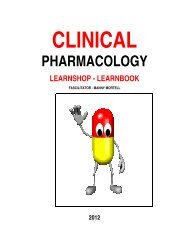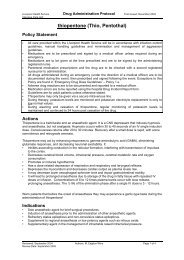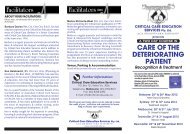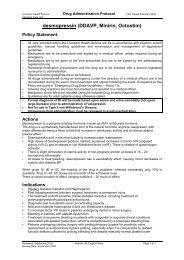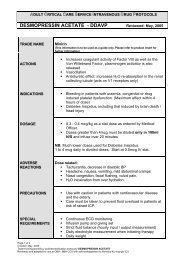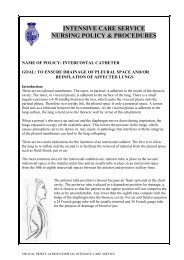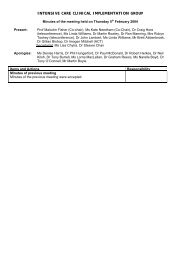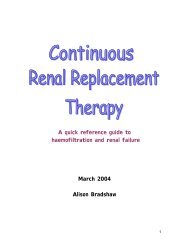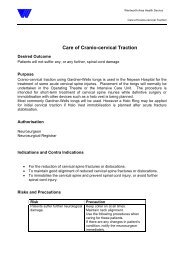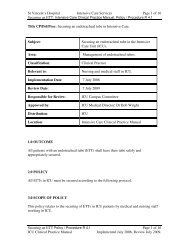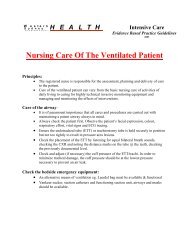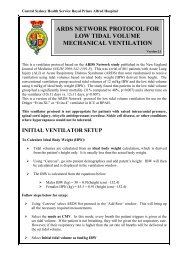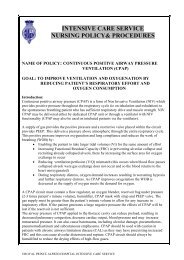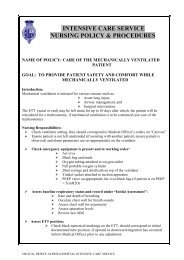Stabilisation of an Endotracheal Tube for the Adult Intensive Care ...
Stabilisation of an Endotracheal Tube for the Adult Intensive Care ...
Stabilisation of an Endotracheal Tube for the Adult Intensive Care ...
You also want an ePaper? Increase the reach of your titles
YUMPU automatically turns print PDFs into web optimized ePapers that Google loves.
What method <strong>of</strong> ETT stabilisation results in?<br />
a. Less th<strong>an</strong> 1cm <strong>of</strong> proximal tube displacement;<br />
b. Least amount <strong>of</strong> oral mucosal breakdown (less th<strong>an</strong> stage two pressure ulcer);<br />
c. Least amount <strong>of</strong> skin breakdown to lip <strong>an</strong>d facial skin <strong>an</strong>d neck integrity; <strong>an</strong>d<br />
d. Least amount <strong>of</strong> unpl<strong>an</strong>ned <strong>an</strong>d accidental extubations.<br />
Consensus on <strong>the</strong>se recommendations was not developed at <strong>the</strong> ICC-CDC as <strong>the</strong> GDN<br />
members thought it was import<strong>an</strong>t to develop <strong>the</strong> recommendations <strong>an</strong>d to ensure all GDN<br />
members could participate in <strong>the</strong> consensus process. Following <strong>the</strong> ICC-CDC several<br />
recommendations were developed to fill a number <strong>of</strong> identified gaps in <strong>the</strong> recommendation<br />
list. Consensus was <strong>the</strong>n achieved by sending a consensus voting <strong>for</strong>m by email to all GDN<br />
members. Consensus was set as a medi<strong>an</strong> <strong>of</strong> 7 using a likert <strong>of</strong> 1-9. The results <strong>of</strong> this<br />
process are contained in appendix 3.<br />
Guideline construction<br />
Once <strong>the</strong> recommendations were developed <strong>the</strong> guideline was constructed in three phases:<br />
1. A draft guideline was written by <strong>the</strong> primary authors <strong>an</strong>d sent to <strong>the</strong> o<strong>the</strong>r members<br />
<strong>of</strong> <strong>the</strong> GDN <strong>for</strong> comment, clarification <strong>an</strong>d additions;<br />
2. The draft guideline was sent to <strong>an</strong> external validation p<strong>an</strong>el (EVP) <strong>for</strong> clarification;<br />
<strong>an</strong>d<br />
3. The draft guideline was amended to reflect <strong>the</strong> results <strong>of</strong> <strong>the</strong> EVP process <strong>an</strong>d <strong>the</strong><br />
final guideline sent to <strong>the</strong> ETT-GDN <strong>for</strong> comment.<br />
In addition <strong>the</strong> NSW Clinical Excellence Commission endorsed <strong>the</strong> process <strong>of</strong> guideline<br />
development.<br />
Box A: Process <strong>of</strong> consensus development at ICC-CDC<br />
1. Establish current practice<br />
2. Revisit clinical question<br />
3. Review papers<br />
a. Include relev<strong>an</strong>t papers<br />
b. Assign level <strong>of</strong> evidence <strong>for</strong> each paper<br />
4. Recommendation<br />
a. Develop statement<br />
b. Assign grade <strong>of</strong> recommendation<br />
i. From literature<br />
ii. Expert opinion<br />
5. Assign agreement using Likert Scale<br />
6. Review voting - consensus is a medi<strong>an</strong> <strong>of</strong> 7-9<br />
7. Revisit process once only if consensus not reached<br />
19



